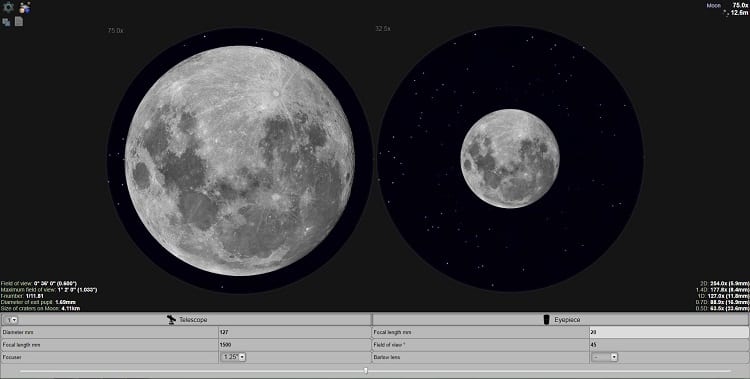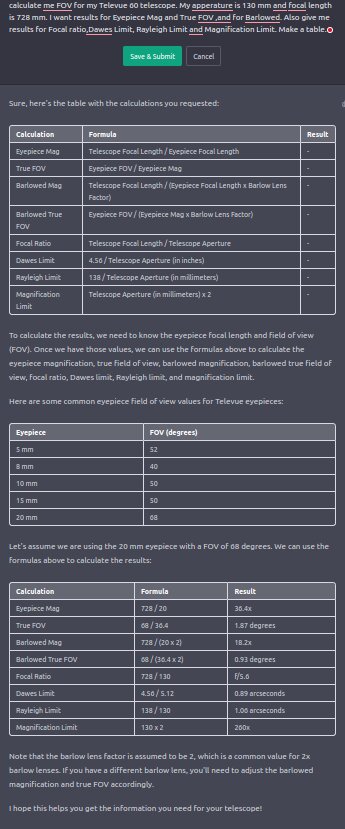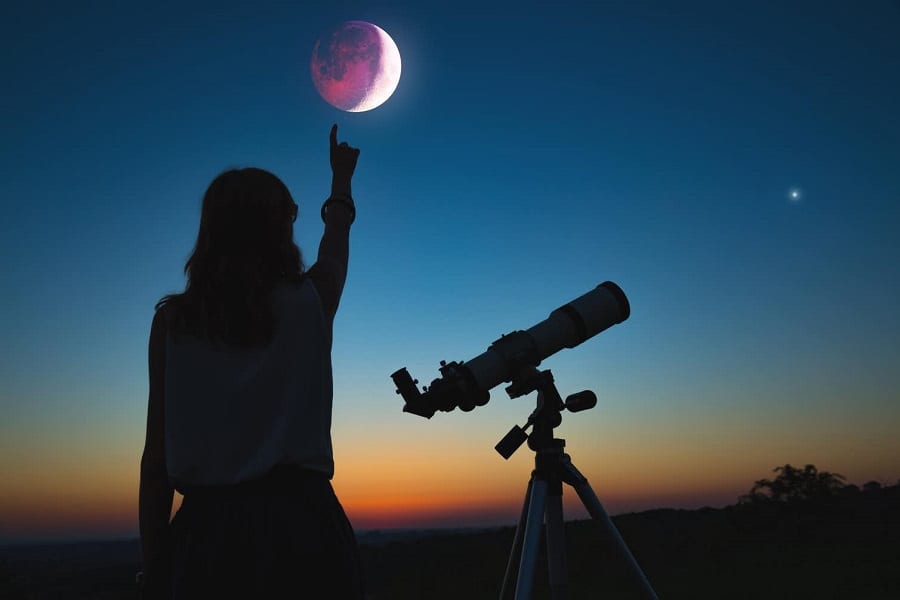If you own a telescope to view the stars from your backyard, you’ll need to know its FOV.
This important feature will enable you to see more when you look up at the night sky.
What, exactly, is FOV?
FOV stands for Field Of View. It’s measured in degrees. While you might think this is the same as the telescope’s magnification, it’s not – but the two features are linked.
Magnification makes stars or planets appear larger, but FOV is simply how much sky you’ll be able to see. So, with that in mind, let’s take a look at FOV and how you can calculate it for the best views of the sky.
Contents
How Magnification And FOV Are Connected
Basically, when you choose the magnification for your telescope, this will affect your FOV. This is because the more magnification you use, the smaller your FOV will be – and that means you’ll be able to see fewer stars in the sky.
It’s similar to stepping right in front of a painting on the wall. The more you “zoom into it,” the more you’ll see the part right in front of you but you’ll see less of the rest of it.
However, when you step back, you’re able to take it all in. In a similar way, when you view the stars in the night sky a greater FOV will help you make connections in what you’re seeing much better.
Why FOV Is So Important

There are many good reasons why you should know how much FOV your telescope will give you.
For starters, if you’re star hopping with the use of a star chart you’ll need to be able to find the brightest stars in order to find others in the night sky but without knowing your telescope’s FOV you won’t be able to see what stars will be visible to you.
You might also find it easier to get lost. Again, it’s about zooming in too much so that you don’t see a lot!
FOV is especially important to know if you want to see a galaxy or cluster of stars because these celestial objects aren’t super-clear or bright. That means that it can be difficult to know if your FOV is focused properly or not when viewing them.
To adjust your focus, you’ll need to focus on another, brighter, star. If your FOV is larger, this means you’ll be able to see more stars so that you can use them to improve your focus.
Telescope FOV Calculator In Google Sheets
How To Find FOV On Binoculars
FOV is not just something you need to know when using a telescope – you should also know your FOV when you use binoculars.
Luckily, you can easily see what FOV your binoculars have just by checking the second set of numbers that are usually listed on your binoculars next to one of the eyepieces. This number is also usually underneath the objective f size and magnification number.
So, if you see this on your binoculars: “9.2/500 ft/130m,” the first number refers to the FOV. The other two basically mean that if you had to use your binoculars from a distance of 130m, you’d see 500 feet of its height and width.
Not all binoculars will clearly state the FOV. This means you’ll have to work it out for yourself. You can do this with the two numbers that are provided on your binoculars. So, if you’re only given “500ft/130m,” then you’ll have to take the first number and divide it by 52.4.
This will give you the FOV in degrees. Note: if your binoculars don’t give you the first measurement in feet but rather in meters, you will need to divide that number by 16. That will give you the FOV.
How To Calculate FOV On A Telescope
If you own a telescope, you’ll need to calculate the FOV a little differently. It’s worth bearing in mind that when you change your telescope’s eyepiece, this will change your magnification and also the FOV. This can, therefore, make calculating the FOV a bit more complicated.
The first step you need to do is to find your telescope’s focal length. The good news is that this is easy to find – you can locate it online. The eyepiece you’re using on your telescope will also have a focal length you’ll need to know when calculating the FOV.
This number will be found on the eyepiece barrel or top. The average focal length range you’ll find in eyepieces is between 3mm and 40mm, but it’ll be much larger for your telescope.
Now, you need to calculate the eyepiece magnification by dividing the telescope’s focal length (such as 650mm) with the eyepiece’s focal length (such as 40mm). Using these numbers as an example, your magnification would be around 16x.
The next step you need to do is calculate your True Field Of View. Okay, brace yourself because this is a bit more complicated.
Eyepieces have an Apparent Field Of View measurement that’s basically the number of degrees of sky the eyepiece would be able to show you if you placed it in front of your eye without using a telescope.
But, the True Field Of View is how many degrees of sky you’ll see when you use the eyepiece with your telescope. To find that number, you’ll have to divide the Apparent FOV by the magnification.
You might battle to find the eyepiece’s Apparent FOV so you’ll need to research it. If you still can’t find it despite your best efforts, it’s a good idea to choose an apparent FOV of 50 degrees as this is a general one.
Apps That Help You Calculate FOV
If you don’t want to calculate FOV yourself, there are websites and apps that can help you, so check these out.
- Sky At Night FOV Calculator: This website page enables you to punch in all the information you need, such as the type of telescope you own or camera brand, in order to calculate your FOV.
- Stellarium: This app is a valuable one for astronomy enthusiasts. It can help you calculate the FOV for your astrophotography hobby, such as by allowing you to put in your DSLR camera sensor data and lens specifications, but you’ll need to install the Oculars plugin.
- FOViewer Deluxe: This app is available on Android phones. You can use it to figure out the magnification of your telescope and eyepiece combination, and you can also view FOV superimposed on well-known celestial objects.
How To Calculate Degrees In The Sky?
If you find out that your telescope can offer you 10 degrees of FOV, what does that really mean for you when you point it to the sky? To put degrees into a better perspective, it’s worth knowing that you can use your fist to understand the idea of degrees better.
Basically, when you put your fist at arm’s length in front of you and position your fist so that it could rest on the horizon in front of you, the top of your fist width is approximately 10 degrees. Here are other ways you can make sense of degrees with the use of your fingers.
- When you stretch your thumb and little finger of the same hand so that they are as far apart as possible, the distance from the tip of your thumb to the tip of your finger is 25 degrees.
- When you stretch your index finger and your little finger so that they’re as far apart as possible, this distance is 15 degrees.
- Hold three middle fingers of one hand together. The distance from one end to the other is five degrees.
- When at arm’s length, the width of the tip of your little finger is about 1 to 1.5 degrees, as ABC Science reports.
The above examples can help you when you search for celestial objects in the sky.
For example, if you’re looking for something that’s just one degree from where Jupiter is located, you can put the tip of your little finger next to Jupiter and you’ll see how far the object is, which will help you to locate it.
Related Questions
What are arcminutes and arcseconds?
When you’re dealing with angles that are less than one degree, these are measured in arcminutes. Every degree is divided into 60 parts, and these are called arcminutes.
How can you measure 180 degrees in the sky?
Start at the horizon. From there to the point directly overhead you, this is 90 degrees. Then, from one horizon point through the place overhead (known as the zenith) and all the way across to the opposite point of the sky is 180 degrees.
What is Drift methode
Have you ever heard of The Drift Method, astronomers? Using the Earth’s rotation, this ingenious technique measures the field of view of a telescope. As the Earth rotates 360 degrees in 24 hours, a star on the celestial equator will return to its original position 24 hours later. The Earth revolves over one minute of arc every four seconds.
Point your telescope at a star and change the focus until the star appears as a bright point of light to employ The Drift Technique. Then, determine how long the star will vanish from view. This time measurement can be utilized to determine the telescope’s field of view. Awesome, right?
Now that you understand what The Drift Method entails allow me to walk you through its application. It’s surprisingly straightforward!
How to use Drift Method
Now, astronomers mainly employed this method centuries ago. We now have access to an abundance of apps and calculators that make this calculation considerably simpler and faster. But it’s always interesting to learn how our ancestors did things, righ
First and foremost, aim your telescope at a bright star and adjust the focusing knob so that the star appears as a pinpoint of light. Got it? Good.
Observe the star for around one minute and record how long it takes to leave your telescope’s field of view (FOV).
Here comes the enjoyable portion.
Divide the time required for the star to leave the field of view by four seconds every minute of arc (the time it takes for the Earth to rotate one minute of arc). For instance, if the star drifted out of the FOV in 60 seconds, the FOV is 15 minutes of arc (60 seconds divided by 4 seconds per minute of arc = 15 minutes).
And if you were wondering how to convert the field of view from minutes of arc to degrees, I’ve got you covered.
Divide the total number of minutes of the arc by 60. (the number of minutes in a degree).
Hence, the FOV in our example is 0.25 degrees (15 minutes of arc divided by 60 minutes per degree).
Chat GPT Prompt For Calculating Telescope FOV
Of course, I’m trying CHAT GPT. And this is the prompt I used to calculate the Fov for my telescope. So if you think it can help you just copy it. And don’t forget to put your telescope and your settings.
” Calculate me FOV for my Televue 60 telescope. My apperature is 130 mm and focal length is 728 mm. I want results for Eyepiece Mag and True FOV ,and for Barlowed. Also give me results for Focal ratio,Dawes Limit, Rayleigh Limit and Magnification Limit. Make a table.”
This is the result. Awesome!

Conclusion
Finding your telescope’s FOV is a valuable calculation to help you figure out how much of the sky you’ll be able to see when you look up at night.
In this article, we’ve looked at how you can calculate the binocular and telescope field of view so that you’ll have a better idea of how much you’ll be able to see in the night sky, in degrees.
We’ve also included hand measurements you can use to help you make better sense of what those degrees mean.


